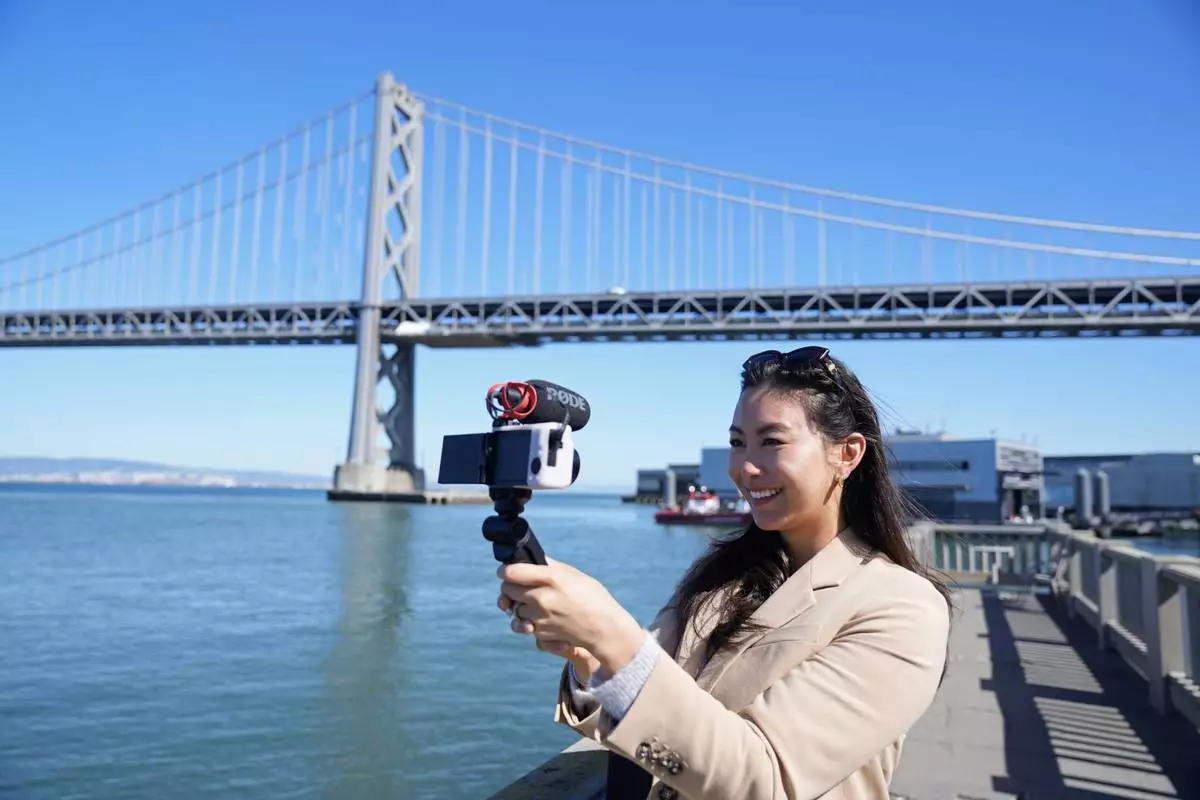The popular video-maker says cancel culture is ruining the experience on the video-sharing platform.
YouTube’s golden age is over and has been replaced by a dark place, popular YouTuber Joey Graceffa has claimed.
He blamed increased anger and fear in the world for the shift.
The 27-year-old, who has almost nine million subscribers on his main channel on the video-sharing website, believes the algorithm on YouTube favours “negative energy”, with people focusing on cancel culture, where controversial comments or activities from a person’s past are dug up.
“The direction it’s in right now, I don’t personally agree with the types of videos and content that does well,” Mr Graceffa explained.
“I definitely think there was a golden age of YouTube but currently now it’s a bit of the dark times, and hopefully we’ll get out of that soon.”
The video-maker said he feels as though people want to see others fail, turning the platform into a “very scary and dark place”.
He also argued that there is not enough support for popular YouTubers to deal with the pressures of online fame.
“People will literally be targeted and get non-stop harassment and I honestly don’t think there’s anything anyone can do,” he explained.
“It’s just a mob mentality that people fall into, where if someone has a narrative of someone and people want to believe that narrative, there’s no talking sense into anyone – there’s no getting anything across, people have what they have in their minds and all it takes, I guess, is time for that to go away.”
Big companies have made it harder for individuals to compete, Mr Graceffa continued, because they have big budgets for higher production values.
Responding to the concerns raised, a YouTube spokeswoman commented: “We always appreciate feedback from the YouTube community and are committed to supporting our creators and helping the platform thrive.”
Despite the issues, the American YouTuber, who will appear at the first UK VidCon conference for video-makers next week, still finds the site fun and has no intention of retiring.
“If I go a week without posting – which is very rare – I always deeply miss YouTube and the connection that I have with my audience,” he said.
With a compact mirror in one hand and an eyelash curler in the other, Grace Xu told her roughly 300,000 TikTok followers she was likely about to be laid off.
She was right, she tells them in a subsequent clip. But she was planning to pursue a different career anyway: as a content creator.
“I guess the decision has been made on my behalf,” she tells viewers in the video posted earlier this year. “The universe has spoken.”
By all accounts, the U.S. job market is holding strong, with employers adding 303,000 workers to their payrolls in March. The jobless rate has now remained below 4% for 26 straight months, the longest such streak since the 1960s.
But that's of little comfort to the thousands of people who have nonetheless found themselves out of work. Hiring has largely been concentrated to a few industries, while tech and finance have only added a small number of jobs in the last 12 months.
Rather than trying to return to traditional employment, however, people like 26-year-old Xu are carving a new path for themselves through online content creation, where they can make money from brand deals and advertising by producing social media videos ranging from educational to entertaining.
“I think most employees look at employers now and no longer think that they are going to find security — permanent security — in a job,” said Sarah Damaske, who studies labor and employment relations, and sociology at Penn State. “I think it makes it less risky to do something like go and be a content creator because employment with a traditional employer is so much riskier.”
In an estimated $250 billion industry, 4% of global content creators pull in more than $100,000 annually, according to Goldman Sachs Research. YouTube — considered by creators to be one of the more lucrative platforms — has more than 3 million channels in its YouTube Partner Program, which is how creators earn money. A spokesperson said the platform paid out more than $70 billion in the last three years.
Meanwhile, TikTok — which faces the threat of a national ban that could cost many creators an income stream — has seen a 15% growth in user monetization, according to a company spokesperson.
Many people turn to full-time content creation only after they've seen a payoff from putting in the work, said Brooke Erin Duffy, a professor of communication at Cornell University. Or they are forced into it, as an avenue back to employment.
The pandemic also reshaped how employees consider work, with many preferring to have more control over their schedules and the ability to do their jobs from home. In February, nearly 440,000 people applied to start their own businesses — up nearly 50% from a monthly pace of 300,000 just before the pandemic, according to the U.S. Census Bureau.
Among them are content creators, although they likely make up only a small portion.
For Xu, the pandemic allowed her to rediscover her hobbies. She started making content at that time as @amazingishgrace on TikTok. Her thrift flips — all sewn by hand — went viral and steadily built up a following. Even when she left her banking job to move into the tech sector for a better work-life balance, she kept on making content.
When a round of layoffs happened last summer, Xu wondered if she should go to content creation full time, despite a deep fear of ruining things she loved by turning them into work. Her own layoff sped up her timeline.
“You just have to have this belief that, like, once your life is wide open for something, it will come,” she said, "otherwise you’ll drive yourself crazy thinking about it.”
Another content creator, who goes by Pot Roast’s Mom on TikTok, described staying in her engineering job for so long because she was afraid of not having health insurance while also having to pay off her student loan. But when her eponymous cat, Pot Roast, died two years ago, she turned to content creation full time.
“Her death just like revealed, or I guess opened my eyes, to that I liked nothing in my life besides her,” said Pot Roast’s Mom, who goes by her username to protect her privacy. "And when she died, I was like, OK, it’s time to make some changes.”
A community of women in the industry helped her shift from traditional employment to full-time content creation by demystifying brand deal pricing, and setting up payment tiers on platforms like Patreon, a subscriber service for content creators.
She has accrued 1.2 million followers on TikTok and a majority of her income came from Patreon last year — about $30,000 — with a small portion coming from brand deals, around another $10,000.
Pot Roast’s Mom saw a video recently where a woman said making cat content earned her $200,000 in a year. More than likely, she said, that was a one-off.
“I think if you do something like this, you have to be ready to fail, ready to not make a lot of money,” she said. “You have to be realistic.”
Indeed, it takes time, energy and resources to turn content creation into a successful career, Duffy said. Creators have to negotiate multivideo brand deals or sponsorships to have a semblance of steady income, but those can have monthslong payout dates. Some rely on savings from their traditional careers to plug the gaps while they wait.
“The level of unpredictability when you’re dependent on a platform is quite profound," she said. "Your success is dependent upon an algorithm or updated community guidelines or an audience that may or may not like you on any given day.”
Cynthia Huang Wang tried her hand in full-time content creation after she was laid off from her brand marketing job in February 2023. In January, she posted a TikTok about returning to the workforce, taking her 164,000 TikTok followers along as she updated her resume.
With the job market improving, Wang said she sees the appeal of returning to a stable income. Maternity leave at a corporate job also has pull as she and her husband consider starting a family.
There are limitations, though, to what she’s willing to return for, including pay, title and work she’s interested in doing.
“Going back to the office every day would be a nonstarter for me,” she said. “I think maybe like two, or max three, days because I still want to be able to create content. And I think going into the office every single day would really impact that.”
Associated Press Staff Writer Chris Rugaber in Washington contributed to this report.

Content creator Cynthia Huang Wang poses with her phone and camera in San Francisco, Monday, April 8, 2024. Despite a strong job market, there are still thousands of people who have found themselves out of work across industries stretching from tech to retail to media. But rather than trying to find another job in their old role, some workers are turning to online content creation. (AP Photo/Eric Risberg)

Content creator Cynthia Huang Wang works below the San Francisco-Oakland Bay Bridge in San Francisco, Monday, April 8, 2024. Despite a strong job market, there are still thousands of people who have found themselves out of work across industries stretching from tech to retail to media. But rather than trying to find another job in their old role, some workers are turning to online content creation. (AP Photo/Eric Risberg)

Content creator Cynthia Huang Wang poses near the Embarcadero in San Francisco, Monday, April 8, 2024. Despite a strong job market, there are still thousands of people who have found themselves out of work across industries stretching from tech to retail to media. But rather than trying to find another job in their old role, some workers are turning to online content creation. (AP Photo/Eric Risberg)

Content creator Cynthia Huang Wang edits work near the Embarcadero in San Francisco, Monday, April 8, 2024. Despite a strong job market, there are still thousands of people who have found themselves out of work across industries stretching from tech to retail to media. But rather than trying to find another job in their old role, some workers are turning to online content creation. (AP Photo/Eric Risberg)

Content creator Cynthia Huang Wang works along the Embarcadero in San Francisco, Monday, April 8, 2024. Despite a strong job market, there are still thousands of people who have found themselves out of work across industries stretching from tech to retail to media. But rather than trying to find another job in their old role, some workers are turning to online content creation. (AP Photo/Eric Risberg)

Content creator Cynthia Huang Wang works below the San Francisco-Oakland Bay Bridge in San Francisco, Monday, April 8, 2024. Despite a strong job market, there are still thousands of people who have found themselves out of work across industries stretching from tech to retail to media. But rather than trying to find another job in their old role, some workers are turning to online content creation. (AP Photo/Eric Risberg)











